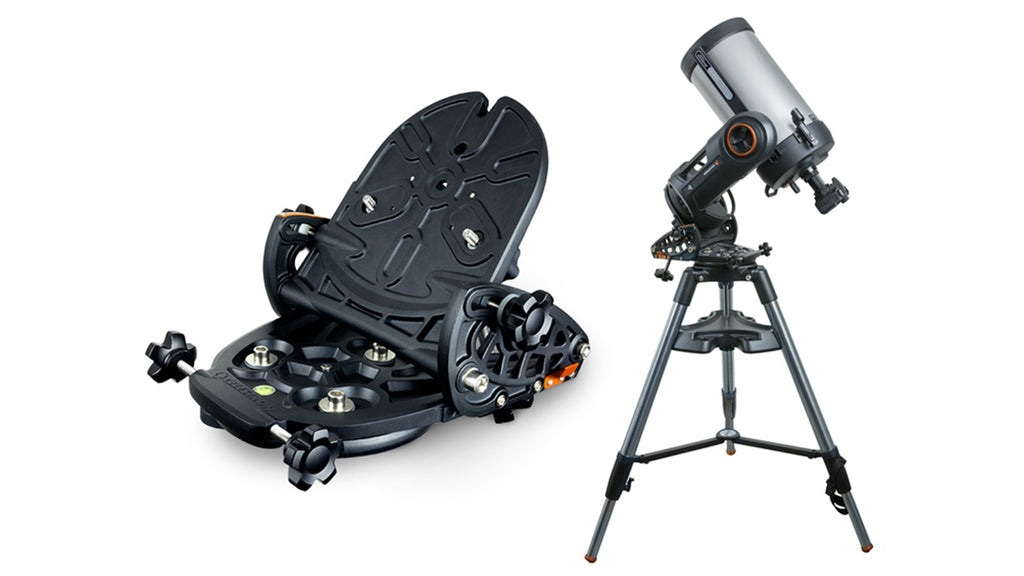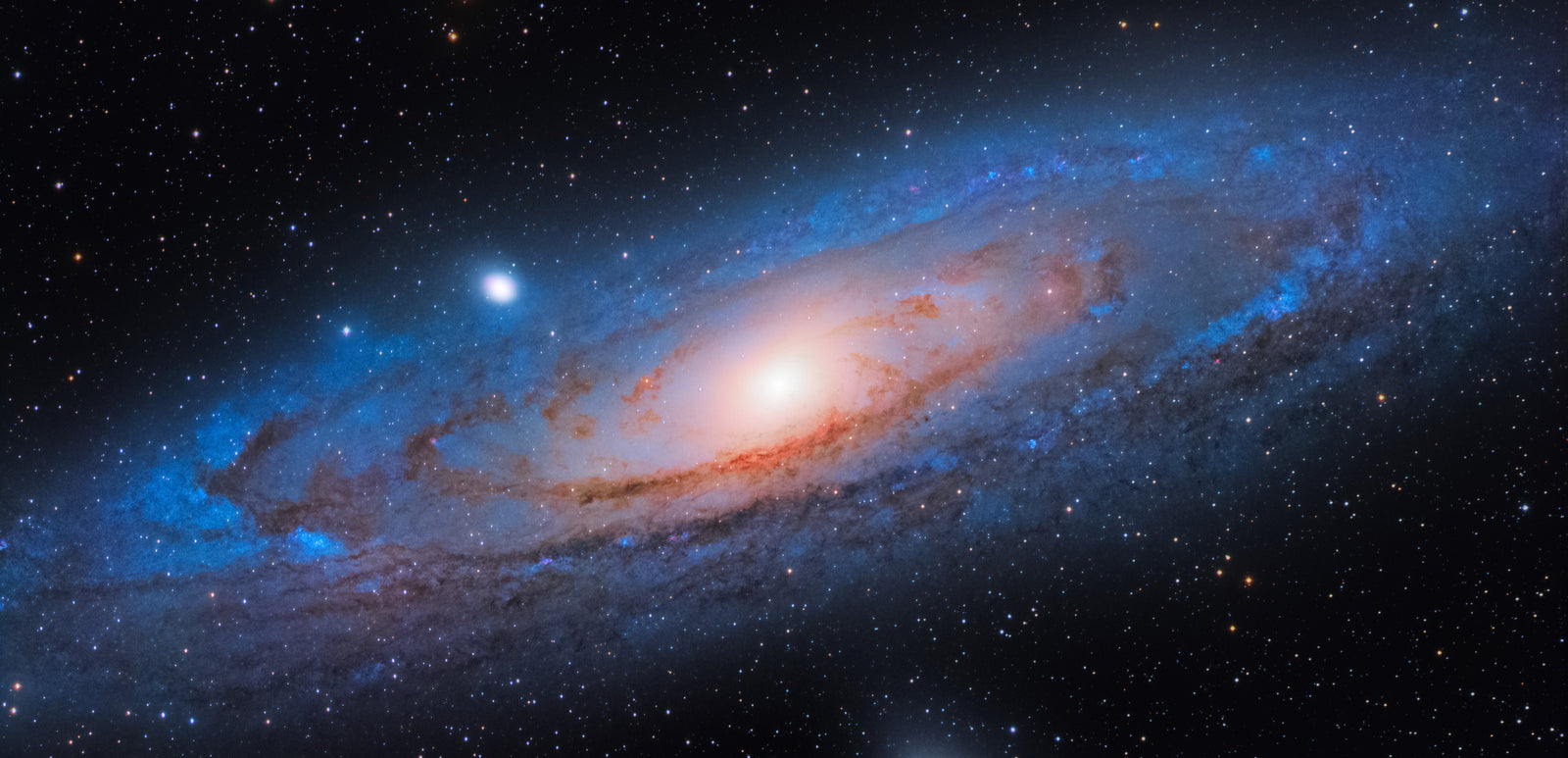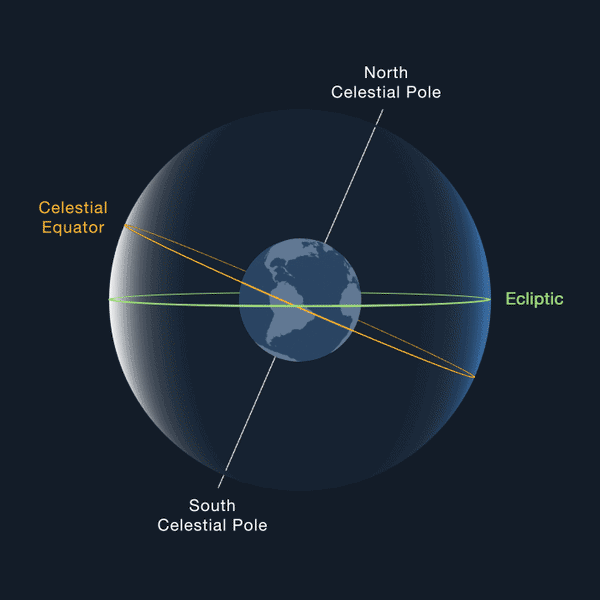Understanding Equatorial Mounts
There are many types of equatorial mounts, but they can all be split up into four main categories: German Equatorial Mounts, Star Trackers, Hybrid Mounts, and Equatorial Wedges. Below, we'll go over these four main types along with their sub-types and what their best uses are.
Introduction to Equatorial Mounts
Equatorial mounts have the ability to track celestial objects all night long with a high degree of accuracy and are primarily used for astrophotography. As the Earth rotates through the course of the night, the stars to appear to move in an east to west motion just like the sun does when it rises and sets each day. Because of this motion, a telescope mount must move at the opposite rate that the Earth spins to keep objects in the sky centered in view through a telescope. All telescope mounts have this ability, but equatorial mounts in particular notes the user's location via latitude by adjusting the angle the mount is tilted at. This allows the mount to not only keep a celestial object centered in view, but keep it from appearing to rotate as these objects follow their natural arc motion across the sky over many hours.
Overall, this ability to keep objects centered translates to a mount type that is ideal for astrophotography, and particularly deep sky astrophotography. With a properly aligned and balanced equatorial mount, especially German Equatorial Mounts, you can take ultra-long exposures of the night sky and expose details in the faintest nebulae and galaxies in space.
Not all equatorial mounts are created equal. These mounts come in many shapes and sizes, and perhaps the most important specification of any equatorial mount is its payload capacity. The payload capacity of a mount is how much weight the mount can adequately carry and still perform as well as it's designed to. If a mount has a payload capacity of 44lbs (20kg), that is the weight limit of a telescope it can carry and still track the night sky accurately.
However, this comes with a caveat for deep sky astrophotography. With deep sky astrophotography, the level of accuracy one must have with the mount is extremely high, especially with today's longer focal length telescopes and high-resolution camera sensors. For deep sky astrophotography, the rule-of-thumb is to keep the total weight of the telescope, camera, and any other accessories riding on the mount at half of the total payload capacity or less. This will ensure that the mount will be able to perform well even at the level of accuracy needed for deep sky imaging.
Equatorial mounts are heavier and require a longer setup time than altitude azimuth mounts. With equatorial mounts, polar alignment is the most important step in setting up the mount. This is the process of aligning the mount with the north or south celestial pole, which allows the mount to spin on the same axis that the Earth does. Polar alignment greatly affects the mount's performance. The more accurate the polar alignment is, the better the tracking performance and therefore the longer exposures can be before stars begin to trail.
The North & South Celestial Poles, which equatorial mounts polar align to
Another critical step in setup with most equatorial mounts is balancing the mount. Most equatorial mounts utilize a counterweight system to balance the telescope. They reduce torque and strain on the geared motors that allow the mount to track the night sky. An improperly balanced mount can lower mount performance and even damage the mount if there is a great imbalance.
Equatorial mounts certainly require more accuracy, precision, and setup time than more simple altitude azimuth mounts. Despite this, a quality equatorial mount can provide a beautiful uperformance for photographing the night sky. It can also produce stunning images of space even right from your backyard. Below, we'll dive into the different types of equatorial mounts and their best uses.
German Equatorial Mounts

Best for deep sky astrophotography with a telescope
German Equatorial Mounts, or GEMs, are the ideal choice for deep sky astrophotography as well as planetary astrophotography with a telescope. Although GEMs come in many shapes and sizes, they all have a few things in common: these mounts employ a counterweight system to offset the weight of the telescope. By doing this, a well-balanced GEM all but eliminates unnecessary torque on the gears that are used to drive the mount. This in turn leads to high levels of tracking performance at an affordable price point, but at the tradeoff of being heavier and less portable.
For most amateur astronomers, a quality German Equatorial Mount is the right choice to capture the very long exposures required for deep sky astrophotography. Although these mounts can be used for visual astronomy too, they can present awkward viewing angles when looking through an eyepiece. For visual use, an alt-azimuth mount is a better choice. Alternatively, a hybrid AZ/EQ mount can do both visual and astrophotography well, but at the cost of a higher price than a German Equatorial Mount of equal payload capacity. All in all, though, the German Equatorial Mount is the best choice for imaging with anything other than a small telescope or camera lens.
Shop German Equatorial Mounts
Star Trackers

Best for beginning astrophotographers and those who want ultimate portability
Star trackers are a perfect choice for those looking to enter the hobby of astrophotography, especially those who already own a DSLR/Mirrorless camera. Most star trackers carrying a DSLR/Mirrorless camera and a lens can track the night sky with ease, which allows for exposures many times longer than just a normal tripod. These mounts are best for imaging widefield targets like the Milky Way Galaxy and some larger deep sky objects like the Orion Nebula when paired with a longer focal length lens or telescope.
Unlike their close German Equatorial Mount cousins, star trackers are designed to carry a light payload, are much more portable, and aren't as expensive. Another key difference from German Equatorial Mounts is that most star trackers don't have go-to capability, meaning you'll have to point them manually. Some heavier-duty star trackers, like the Star Adventurer Pro or SkyGuider Pro, can carry enough weight to hold a telephoto lens or even a small and ultralight refractor telescope such as the Radian Raptor 61. Although these star trackers can't track as accurately as larger German Equatorial Mounts and often only track in one axis (RA) instead of two, they are usually still a great choice for anyone just starting out in astrophotography.
Explore Star Trackers
Hybrid Mounts

Best for both visual and imaging, but at a higher price point
Hybrid mounts utilize the best of both worlds and can be used in both alt-az mode and equatorial mode — usually shortened to AZ/EQ. This makes them great tools for both visual observing and imaging, which is ideal for those who enjoy swapping back and forth between the two such as for public outreach events. Unlike converting an alt-az mount to an equatorial mount by using a wedge, these hybrid mounts have a true counterweight system like German Equatorial Mounts do, and can therefore be used with excellent results for astrophotography. When used in alt-az mode, some hybrid mounts can even carry two telescopes of similar weight at once. This can give an added benefit of observing at multiple focal lengths without swapping eyepieces. Of course, the added functionality of both AZ and EQ modes mean that hybrid mounts cost more than alt-az or equatorial mounts on their own, but hybrid mounts are a fitting choice for those who frequently do both.
Explore Hybrid Mounts
Equatorial Wedges for Alt-Az Mounts

Best for using an alt-az mount equatorially
Altitude-azimuth mounts have the ability to become equatorial mounts with the addition of a component called an equatorial wedge. The wedge sits between the mount and the tripod and allows the user to tilt the mount to an angle matching their location's latitude. By doing this, the wedge allows an alt-az mount to be used equatorially and therefore can track the night sky without any field rotation for astrophotography.
Equatorial wedges are a great choice for planetary imagers who may already own an alt-az mount, and they can also do short-exposure deep sky imaging too. However, for long exposure deep sky imaging, equatorial wedges fall short. This is because unlike German Equatorial Mounts, equatorial wedges don't utilize a counterweight system. This puts added torque on the motors inside the mount as they have to support the entire weight of the telescope. In turn, tracking performance over long exposures can suffer if a heavy-duty mount isn't used, and so equatorial wedges are less ideal for most long exposure deep sky imaging compared to German Equatorial Mounts that use a counterweight system. Overall, equatorial wedges can be an excellent choice for those looking to upgrade their existing alt-az mount to track equatorially on a limited budget.
Explore Equatorial Wedges
Which equatorial mount should I buy?
If you're looking to begin deep sky astrophotography with a camera lens, go with a star tracker. Looking to enter the world of deep sky or planetary imaging with a telescope? Go with a German Equatorial Mount. If you're hoping to have the ability to use your mount for both astrophotography and frequent visual observing, go with a hybrid mount. And, if you have an alt-az mount and would like to upgrade to an equatorial mount but have a limited budget, consider an equatorial wedge.
How can I improve the performance of my equatorial mount for astrophotography?
There are three main ways to significantly improve your mount's performance:
- Improve your mount's polar alignment either manually, with software, or with a polar alignment assisting tool such as the QHY Polemaster or iOptron iPolar
- Properly balance the mount, which includes balancing worm drive mounts (almost all entry-level mounts) slightly east heavy to reduce backlash
- Add an autoguiding setup with a guiding camera and either a guide scope or an off-axis guider if your mount has an autoguiding port
What do terms like worm drive, direct drive, belt drive, and harmonic drive mean?
Equatorial mounts use a variety of drive methods to track the night sky. Worm drive mounts are most common and generally the most affordable as they use a simple worm gear system. Direct drive mounts are usually reserved for high-end mounts and use a friction-based system to move the mount. Belt drive mounts use belts instead of gears to move the mount. Harmonic drive mounts use a gear system, albeit with higher quality gears that allow for carrying payloads many times heavier than the mount itself, making them highly portable. Each type of mount drive has their own strengths and weaknesses, but the drive method is not usually something a beginner should factor into their buying decision.
How do you attach a telescope to the mount?
Telescope mounts have a part called the saddle, which is where the telescope connects to the mount. The part of the telescope that connects to the mount is called the dovetail. The telescope attaches to the mount via the dovetail being clamped down by the saddle, which has knob tightening screws to hold the telescope securely in place. Dovetails and saddles come in two common shapes:
- Vixen / V-style): found on almost all beginner equipment, used to carry smaller & lighter telescopes
- Losmandy / D-style: found on higher end telescope equipment, used to carry larger & heavier telescopes
Some modern mounts feature saddles that can carry both types of dovetails. This is convenient as it lets you swap between smaller and larger telescopes easily without having to remove dovetails. Click here to shop our selection of dovetails.
Payload Capacity
Payload capacity (also called instrument capacity) is the heaviest weight that a mount can carry and still perform as intended. This includes anything riding on top of the mount, such as a telescope, camera, and other accessories. Generally speaking, the rule-of-thumb for deep sky astrophotography is to keep the telescope, camera, and any other accessories at half of the mount's payload capacity for best performance.
Tracking
This is the process of tracking an object as it moves throughout the night sky. If a mount has tracking, it likely means it has motors to keep an object centered in view when looking through the telescope.
Computerized
This means that the mount not only features motors for tracking the night sky, but it also has a built-in computer that can automatically point the mount (and telescope) to an object of your choice and track it. Computerized mounts come with an accessory called a hand controller, which is a wired remote control used to control the mount.
GoTo
Similar to computerized, this specifically means that the mount can "go to" an object of your choosing when you select one on the hand controller. You'll often see "computerized go-to" used together.
Motor Drive / Clock Drive
This usually implies that the mount is not computerized, but still has motors that can track the night sky. You need to manually point the telescope at the object, but it will keep it centered and not drift out of the eyepiece.
Autoguiding
Autoguiding, also known as just guiding, is the practice of using an additional accessory on a telescope to assist in keeping the mount locked onto a star. When guiding, a guide camera can watch a star and communicate with the mount to make adjustments if that star begins to drift out of place. This in turn leads to the mount being able to accurately track for much longer, allowing significantly longer exposures to be taken without star trailing occurring in the images.
Backlash
In some gear-driven mounts like worm drive mounts, there can be slight play between the teeth of two interlocking gears. This can cause the gears to slightly slip when the motors are engaged, which can result in small "jumps" in your mount while tracking the night sky, meaning stars can appear to trail in long exposure images. Backlash can be reduced by balancing your mount slightly heavy on the eastern-facing side of the mount. Higher-end mounts like harmonic drive mounts do not suffer from backlash.
Periodic Error
Periodic error is a measurement of irregularities in the gears. Most mounts use a gear system that makes a complete rotation over a few minutes or so. Due to small imperfections in the gears, it can cause the mount's performance to repeatedly drop at certain intervals, which is what periodic error is. Periodic Error Correction, or PEC, is a common feature in most modern mounts that "learn" what intervals that periodic error occurs and corrects for it.
Latitude Range
Excluding hybrid mounts, most equatorial mounts including star trackers are designed to work at a limited range of latitudes. For example, this can mean that the mount's altitude knobs can only go from 15º to 65º, which is where most observers on Earth live between. Be sure to consider the latitude range if you live near the equator or above the arctic/antarctic circles as some mounts cannot work properly at those latitudes.














